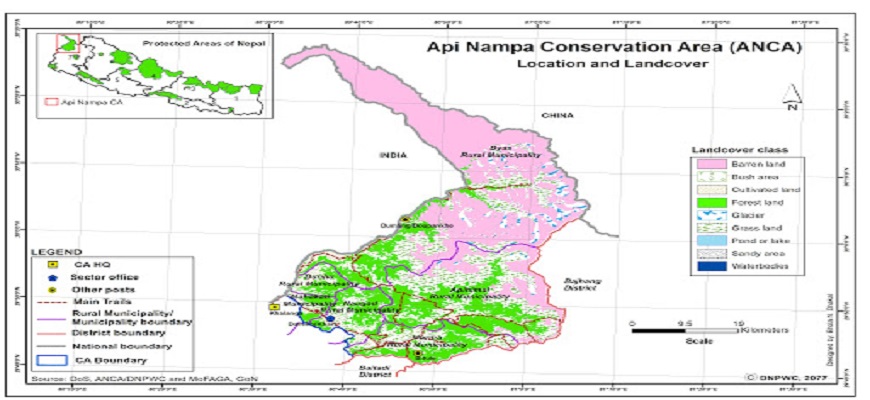Api Nampa Conservation Area is Nepal's youngest conservation area lying in the far-western region of Nepal. It was established in 2010 and named after the two peaks Api (7,132 m)and Nampa (6,757 m) in the Darchula district.
Part of the Kailash Sacred Landscape, Api Nampa Conservation Area covers an area of 1,903 sq km and ranges from 518 to 7,132 m in elevation. The article below discusses the climate, vegetation, and wildlife present in the protected area.
Location of Api Nampa Conservation Area
The ANCA is located in the far-western region of Nepal between 29° 30' to 30° 15' in the northern latitude and 80° 22' to 81° 09' in the eastern longitude.

Map:Api Nampa Conservation
Credit: dnpwc 2079
The protected area covers about 1,903 sq km of land and is spread over 21 Village Development Committees in Darchula. It shares its international border with Tibet while the Mahakali River forms the ANCA's western border.
Baitadi and Bajhang districts lie adjacent to the Api Nampa region. The region includes five Rural Municipalities (Apihimal, Marma, Byas, Naugad, and Dunhu) and a few areas of the Mahakali Municipality (ward no. 1,2, and 3). It also includes one conservation area management council and twenty-five conservation area user committees.
How can we reach Api Nampa region?
You can either catch a plane or take a bus from Kathmandu to Dhangadi. Once in Dhangadi, take a bus that takes you straight to the conservation area's headquarters in Darchula.
There are two entry points to the region from towns Gokuleshwor and Khalanga. These towns can be reached by bus from Dhangadi after driving for 10-14 hrs.

Api Nampa: Himalayan Adventure Beckons
Credit:nepaltraveller.com
Tourists from India can also catch a bus to Darchula from their capital city, Delhi. After crossing the Mahakali River, the border between Nepal and India, you enter the Api Nampa region.
Entry fees
Nepalese citizens are charged NPR 100 while tourist from SAARC countries must pay NPR 500 before entering. Vacationers from other foreign countries are required to pay a fee of NPR 2,000.
Start of the Api Nampa Conservation Area
Considering the conservation of the biodiversity of the northern Darchula district, the Govt. of Nepal started the Api Nampa Conservation Area on 12th July 2010.
The protected area is named after two famous mountain peaks; Api and Nampa. The management of the region is being carried under the guidelines of the Conservation Area Government Management Regulation of 20157 BS.
Weather of Api Nampa Conservation Area
The ANCA's climate is characterized by heavy rainfall and humidity. The environment of the protected area varies with the increase in altitude.
The climate of Api Nampa region varies from Sub-tropical climatic zone to alpine zone. A significant area of the northern part is covered entirely with snow for most of the year as it experiences alpine climate.

Api Nampa: Peaks and Trails
Credit:yetitraveladventure.com
However, the climatic zone in the southern side and valleys is sub-tropical while the mid-hills have a temperate climate. The avg maximum temperature of the region is 18.6° C, and the minimum temperature is 7,7° C.
The area receives maximum rainfall between the months of June to September. The rain in the region lies between 125-350 mm in 24 hrs.
When is the best time to visit Api Nampa region?
The period between Mid-October to November and March to May are the best time to visit the ANCA.
Vegetation of Api Nampa Region
The main objective of the NCA is to protect the unique and flora diversity of the region. The area houses several species of plants like yarshagompa, jatamansi, talis patra, sugandhwal, panchaule, kutki, and many others.
Wildlife in Api Nampa Conservation Area
Due to the various climatic conditions experienced by the area, it has proven to be a prime habitat for several species of birds and mammals.
Birds
The Api Nampa region is home to raptors like Nepal's national bird Danphe (Impeyan pheasant), snow cock, munal, red-billed chough, yellow-billed chough, and blood pheasant.
Mammals
The protected area is home to some endangered species like red panda, snow leopard, blue sheep, musk deer, and Himalayan tahr.
Other species of mammals like the grey wolf (Canis lupus), jackal (Canis aureus), Himalayan black bear (Selenarctos thibetanus), goral (Nemorhaedus goral), serow (Capricornis sumatraensis), and common langur (Semnopithecus entellus) are also present.
People of ANCA
The people living in the 21 VDCs of the ANCA belong to ethnic groups of Brahmins, Bhotiya, Chettri, Kami, Damai, and Sarki. There are over 8,900 households in the area, and the population exceeds 54,400.
Infrastructure
Tourists visiting the area are advised to carry their own medical supplies as there are limited medical services in the region. Accommodations are available in the ANCA but be careful to bring warm clothes for the trip.
Major attractions of Api Nampa region
- Api Himal, Nampa, and Byas (6,670 m)
- The holy places in Byas
- Temples in Dunhu and Marma
- Byasi (Sauka) culture
Trekking routes in ANCA
- Latinath to Api Base Camp passing through Gulzar and Ghusa. The trip takes about 304 days.
- Khalanga to Api Base Camp via Khar, Sipti, and Sitaula which takes about 6-7 days.
- Another trail from Khalanga to Api base camp passing through Huti, Sunsera, Rapla, and Byas which takes 7-8 days.
For more information on the conservation area, please visit Hopnepal.com.















